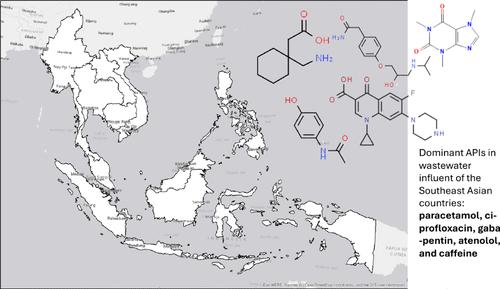Occurrence and Removal Efficiency of Active Pharmaceutical Ingredients (APIs) in Wastewater Treatment Plants: A Systematic Review from Southeast Asia
引用次数: 0
Abstract
Active Pharmaceutical Ingredients (APIs) in the aquatic environment have become a growing concern due to their potential health and environmental impacts. The review aims to examine the occurrence and removal efficiency of APIs in the influent and effluent of wastewater treatment plants (WWTPs) in Southeast Asian countries, including Thailand, Singapore, Malaysia, Indonesia, Vietnam, and the Philippines. The review covers five classes of APIs, i.e., nonsteroidal anti-inflammatory drugs (NSAIDs), antibiotics, anticonvulsants, antihypertensives, and stimulants. We systematically scoured Scopus-indexed articles published from 2011 to 2022 from Google Scholar, PubMed, and Dimensions and extracted measured concentrations of APIs detected in WWTPs. The wastewater influent contained the following APIs from each class in the highest mean or median concentrations: paracetamol (mean: 26,000 ng/L), ciprofloxacin (mean: 567.4 ng/L), gabapentin (median: up to 3609 ng/L), atenolol (median: up to 4124 ng/L), and caffeine (mean: 38,000 ng/L). Moreover, studies in Singapore have recorded the highest treatment efficiency on various APIs compared to those recorded in Malaysia, Thailand, or Vietnam. This study underscores the importance of implementing standardized monitoring techniques, enhancing wastewater infrastructure, and raising awareness among parties involved to address the environmental hazards linked to pharmaceutical pollution effectively.

污水处理厂中活性药物成分 (API) 的存在和去除效率:来自东南亚的系统性综述
由于其对健康和环境的潜在影响,水生环境中的活性药物成分 (API) 日益受到关注。本综述旨在研究东南亚国家(包括泰国、新加坡、马来西亚、印度尼西亚、越南和菲律宾)废水处理厂(WWTPs)进水和出水中原料药的发生率和去除效率。综述涵盖五类原料药,即非甾体抗炎药 (NSAID)、抗生素、抗惊厥药、抗高血压药和兴奋剂。我们从 Google Scholar、PubMed 和 Dimensions 系统地搜索了 2011 年至 2022 年期间发表的 Scopus 索引文章,并提取了污水处理厂中检测到的原料药的测量浓度。废水废水中含有以下平均浓度或中位浓度最高的各类原料药:扑热息痛(平均:26,000 纳克/升)、环丙沙星(平均:567.4 纳克/升)、加巴喷丁(中位数:高达 3609 纳克/升)、阿替洛尔(中位数:高达 4124 纳克/升)和咖啡因(平均:38,000 纳克/升)。此外,与马来西亚、泰国或越南的研究相比,新加坡对各种原料药的治疗效率最高。这项研究强调了实施标准化监测技术、加强废水处理基础设施以及提高相关各方的意识对于有效解决与制药污染相关的环境危害的重要性。
本文章由计算机程序翻译,如有差异,请以英文原文为准。
求助全文
约1分钟内获得全文
求助全文

 求助内容:
求助内容: 应助结果提醒方式:
应助结果提醒方式:


